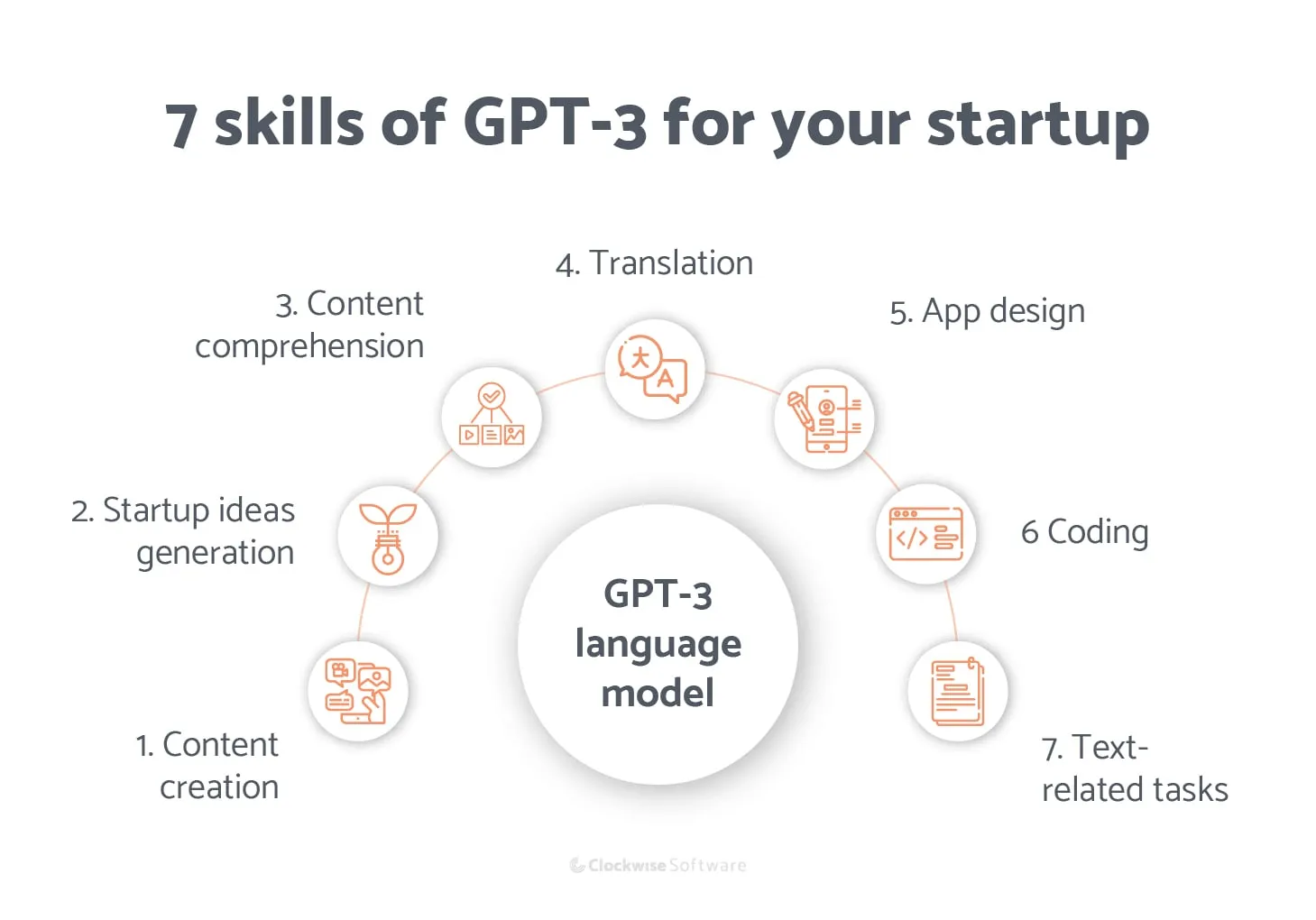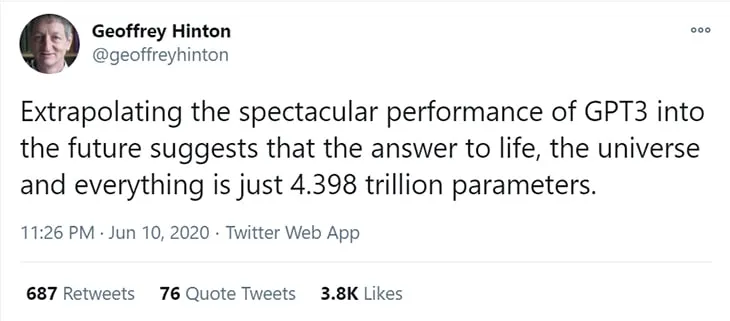What we do
Services
Experts in
As you scroll through your news feed on social media, it’s getting hard to be confident that the author of a text is a human. Even this article could be just another text generated by artificial intelligence — a growing possibility thanks to rapid advancements in AI development services. But is it?
As of June 2020, we can never be sure whether text or a piece of code is created by a human or by GPT-3, a cutting-edge language model. This powerful but terrifying AI is trained by terabytes of digital data and is now capable of understanding semantics, generating texts, providing relative answers, creating code and so much more. We recently highlighted the technologies behind GPT-3; its creator, the OpenAI company; and its key capabilities. Today, we’re going to dive deeper, discuss GPT-3 integrations, and answer a critical question: How exactly can you use OpenAI GPT-3 in your startup?
As a company that provides generative AI integration services, we can tell a lot about GPT-3 integration.
Ready for some impressive use cases? Let’s go.
OpenAI has shared some fascinating insights about GPT-3, which generated an article that is the hardest to date to distinguish from a human-written text. Only 12% of respondents thought that the article was machine-generated.
Take a look at it:

"Language Models Are Few-Shot Learners," page 28
Could you tell this was written by a machine?
The GPT-3 language model is able to perform tasks none of its predecessors ever could. It generates texts that are not just a random mix of words but well-structured insightful opinions with even a bit of emotion.
According to the Journal of Cultural Analytics, “large-scale statistical approaches like GPT-3 are a large—but not entire—part of the puzzle to fully understanding language.”
Humanity is approaching the point when an AI-based tool, maybe even one originating from GPT-3, will be able to pass the Turing test.
The Turing test, or the so-called imitation game, determines if a machine is able to think and analyze data like a human. The test looks like a conversation between a human operator and a machine trained to generate human-like responses. Machine-generated responses are then compared to a human’s responses. The answers don’t actually need to be correct: the point is to find out if it’s possible to distinguish an AI from a human.
GPT-3 still sometimes makes errors in calculations, comes to the wrong conclusions, or generates offensive content. But with a drop of human supervision, it may be a great creative writing tool. Even The Guardian posted an article created by GPT-3, so why not employ its capabilities in your app?
Now, let’s find out what these capabilities are.
No matter how cool, innovative, or profitable your product is, there are multiple ways to make it better. Implementing AI is one of them. But GPT-3 is much more powerful than simple AI implementations used, for example, in a typical chatbot.
OpenAI used an advanced multi-component method for training the most powerful language model ever built. GPT-3 is able to understand a user’s query: not only the words but the semantics, intentions, and even emotions. More than that, GPT-3 can respond to a user’s query in a way that’s hardly distinguishable from a human response. Based on perceived data, analyzed examples, and obtained “knowledge,” GPT-3 can now deal with multiple tasks.
Let’s take a look at seven ways that OpenAI GPT-3 serves real products.

GPT-3 has mastered the skill of creating any type of content, whether it’s a poem, a scenario for a new talk show, or even a new novel by Jerome K. Jerome, may he rest in peace. By mimicking a person’s tone of voice, GPT-3 can even pretend to be any author, politician, scientist, or celebrity whose words, texts, or interviews are stored on the World Wide Web.
Several tools have already been built around GPT-3’s writing skills. Some allow you to talk to a famous person, others mimic the writing style of famous authors like Jerome K. Jerome. GPT-3 can talk like a philosopher and write funny poems. Proofreading is surely required, but GPT-3 has a strong potential to replace bloggers and writers. And that’s far from the end of its capabilities. At this stage, many founders also begin evaluating AI app development cost to understand what it might take to turn such GPT-3 capabilities into a marketable product.
Having been trained to perceive, analyze, and process huge amounts of data — and having been fed terabytes of texts — GPT-3 can answer almost any question. It can ponder the existence of God, generate daily horoscopes, and predict the World Series winner.
This feature may be helpful for creating gpt-based chatbots or automating customer support. Once you provide GPT-3 with enough data about your business, sales process, reimbursement policy, and terms of use, for example, it will be able to generate correct answers and provide immediate help to your customers.
Screenwriting as a form of creative writing is another task GPT-3 integration may accomplish. On the arr.am blog you can read an entire standup comedy generated by GPT-3. The AI wrote a conversation between Peter Thiel, Elon Musk, and Larry Page about running a business.
Texts like cover letters, job descriptions, and resumes can be hard to create. Job seekers put much effort into creating resumes employers will notice, and recruiters and hiring managers create dozens of job descriptions until they finally approve the most attractive one. It gets even worse with cover letters: in order to write a strong cover letter, you need to conduct deep research, learn as much as you can about the company, and pique the reader’s attention with the first sentences.
Again, GPT-3 can do all of this for you.
By integrating GPT-3, a startup might launch a resume building tool and provide users with unique services.
GPT-3 is suitable for generating terms and conditions, agreements, legal documents, and other similar content.
It takes several seconds for GPT-3 to convert plain English into a presentation. There are some weaknesses, however: designs and visual effects may be poor. However, GPT-3 presents a great opportunity to automate routine tasks and quickly get ready for a presentation, meeting, or tech talk.
This may also be a startup idea: create a presentation builder and extend its power with GPT-3 to meet a wider set of needs and provide better service.
Another practical application is songwriting. Feed an app built on GPT-3 with some examples of symphonies and songs and it can generate its own version. The AI analyzes sequences of notes, rearranges them, and creates a melody hardly recognizable from one written by a human.
There’s a vast number of GPT-3 applications that can inspire you to create the next innovative AI-based product.
In the previous section, we gave you several startup ideas to consider. Here, you’ll find out how GPT-3 can help you with brainstorming and launching an in-demand product in the 2020s.
During the pandemic, a myriad of established companies and startups have faded away. At the same time, eCommerce, eLearning, and multiple other industries have been exploding and companies in those industries have been adding zeros to their bank accounts. It’s an enormous challenge to enter a viable niche, identify rising demand, and come up with a solution to meet it. Guess what can help you with that?
GPT-3 can analyze the current market situation, determine the most successful startups, and identify rising market demand to generate fresh and promising business ideas. Look at what we’ve found:

Although some of the ideas may sound impossible or ridiculous, there are numerous ideas entrepreneurs might use to achieve great results.
GPT-3 may turn into a valuable assistant for generating ideas, no matter if they’re about critical business tasks or just a part of a typical workday.
One of the unique features of GPT-3 is its ability to find content not only using keywords but by understanding the meaning of each word. So unlike traditional search engines that primarily use keywords to provide search results, GPT-3 can provide answers based on the topic, the meaning of the search query, and the user’s intention — not just the words themselves. GPT-3 may enable search engines to answer more complex, natural language questions in a shorter time. Algolia, an AI-powered search tool, leverages the OpenAI API to better understand user queries and cut response times to 100ms.
Effective use of GPT-3 may greatly simplify the efforts of SEO experts. These specialists invest tons of time in research and work with tools for identifying keywords and a semantic core to improve web page rankings. With a GPT-3-powered assistant, this task may take seconds. GPT-3 has the potential to revolutionize the entire website content strategy and bring a website to the top of the search results.
We can assume that in the future, web page rankings will be determined by more than keyword density. An article’s real usefulness will make a difference. Hit-or-miss content strategies driven by low-quality content packed with keywords will lose out to intelligent strategies focused on valuable content.
OpenAI calls this feature “Polyglot.” The GPT-3 API works best in English. However, it can translate English to other languages with just a few sentences for context.
Sure, but lots of translation and dictionary apps do the same, you may say. Here’s the difference: while traditional translation software uses a database with words in different languages, GPT-3 learns by itself. It uses information it has already studied during pre-training, compares it to the example, understands the language, the context, and the task, and then translates the phrase.
Translating one language to another is the simplest example of what GPT-3’s Polyglot feature can do. But GPT-3 can also do things like translate legal texts into simple, understandable English.
It also translates English into programming languages and designs. You’ll learn more about that in the next sections.
On Twitter, tech entrepreneurs and enthusiasts are actively sharing amazing results they’ve achieved using GPT-3 to create designs and build app prototypes. This language model can translate plain English into a good-looking prototype for your next application. GPT-3 renders text, generates JavaScript XML code, and draws the layout as described in a query.
App designer Jordan Singer shares his experience working with GPT-2 and GPT-3. In February 2020, he mixed GPT-2’s natural language processing capabilities with Figma design software to create a simple plugin that translates English to a design prototype. Now, with GPT-3’s capabilities, the plugin better understands queries and generates designs that more accurately meet users’ expectations.
The rate of app designers in the US starts at around $40 to $45 an hour. GPT-3 integration means you can minimize your expenses at the initial stages of your startup’s development by converting a text description of a layout to an image. Although GPT-3 is not yet able to fully replace a skilled designer, it may become a temporary solution: design a layout with GPT-3 to attract investment, then hire a qualified professional after you raise funds.
Ready for another impressive GPT-3 use case? This language model is able to code. You already know it’s able to translate English to JSX, but what else can it pull off?
Tailwind CSS, a code generator for swift UI development, allows users to translate text to CSS code. Just describe a layout, click a button, and get a ready-made web app UI.
Debuild.co now allows developers to simply translate English text to React.js code. It takes just seconds to create a simple app and test the concept.
Another tool that integrates GPT-3 is the English to THREE.js translator. By describing elements and parameters, a developer can use this tool to get a 3D scene.
Writing SQL queries is now much simpler. An engineer or a database admin can convert a question to SQL code using GPT-3 in a matter of seconds.
Regex, aka regular expressions, allow for defining search patterns. In software engineering, regex is used to search for strings. For example, to find a string where a change is required, an engineer can write regex code. Some programming languages provide built-in regex capabilities. But GPT-3 deals even with this task. Just enter plain English and GPT-3 will generate regex code for you.
Note: GPT-3 is not (yet) able to replace an entire engineering team. Although it’s pretty strong, it still needs a supervisor, a guide, and someone to control it and review its code. At this stage, GPT-3 integration is a way to build a new generation of apps that assist developers. Routine tasks can now be eliminated so engineers can focus on better app architectures, performance, and creative tasks.
GPT-3’s superpowers don’t stop at generating texts. It’s also able to handle multiple text-related tasks and greatly optimize the work of writers, students, accountants, and business owners.
If you feed GPT-3 War and Peace, you can get a well-explained summary as a result. No matter what text you’re working with, GPT-3 can provide a summary in a matter of seconds. For instance, OpenAI has demonstrated a Summarization tool that translates an NDA into straightforward text that’s easy for kids to understand.
If you need to deal with long and boring emails every day, you understand how great it would be to receive shortened, optimized versions of entire email discussions. The summarization feature of GPT-3 may make for a powerful productivity tool. By saving time on reading emails, you can pay more attention to essential tasks.
GPT-3 also works the other way round. From a short bulleted list, a brief description, or a summary, the language model can generate a detailed, comprehensive text. Trained on a variety of examples, GPT-3 constantly learns how to write better, more accurate texts and can develop an article on any topic based on a few sentences.
Good old spreadsheets will never be the same. Fueled by GPT-3, auto-completion and organization features will get a level-up. With a GPT-3 extension in your app, you define a topic, provide several examples of data to fill spreadsheets with, and autocomplete an entire Excel table. Understanding a task from a topic or description, GPT-3 can search the internet for information and fill in a spreadsheet with needed data.
GPT-3 is good at almost everything. But it’s still prone to making mistakes and may fail to exercise common sense or perform simple mathematical calculations. It may generate wrong answers and offensive content, and although its performance is shocking, it still requires human supervision and is unable to fully replace a human.
But with the great capabilities demonstrated by GPT-3, the question remains: how many machine learning parameters must be fed to a neural network to make its performance impeccable? Or, to put it another way, how many parameters would it take to build a GPT-4 that beats its predecessor in terms of depth of analysis? Is GPT-3 powerful enough to build a truly intelligent, human-like language model?
These are the questions of our time. GPT-3 may not be the perfect, impeccable AI Steven Hawking warned mankind about. But it may be the initial version of a thunderous AI that will change the world.
GPT-3 is one of the hottest topics of 2020. Rising startups as well as established businesses are turning their heads toward this impressive technology and are generating ideas on how to integrate AI into an app. As of now, Microsoft owns the OpenAI API license; however, GPT-3 is still available in beta for other users. So the best time to upgrade your app with GPT-3 integration is now.
We’ve collected several examples of how GPT-3 can improve an app. Take a look:
|
Your project |
What can GPT-3 do? |
|
eCommerce website |
Automatically generate detailed product descriptions Create hyper-personalized content Improve SEO ranking |
|
Two-sided online marketplace |
Power 24/7 AI-based customer support Enable chatbots that can answer any user’s question or concern Improve intelligent search and filtering Smartly match customers with service or product providers |
|
SaaS product |
Extend functionality |
|
Dating app |
Smartly match users Immediately analyze a person’s online appearance |
|
Education app |
Translate texts Enable interactive learning Simulate discussions of a topic with a scientist or celebrity Summarize lessons Extend summaries or short notes to large texts |
|
MVP for a web-based project |
Generate viable ideas Design a prototype Improve SEO Translate content Generate terms and agreements and privacy policies |
Powered by a huge number of machine learning parameters, a language model like GPT-3 may learn to answer questions humans don’t have enough information to answer. Thus, GPT-3 has the potential to turn from an intelligent assistant to an all-wise AI:

